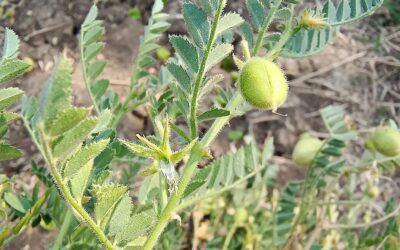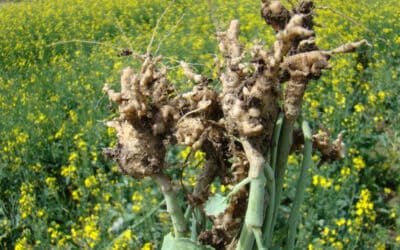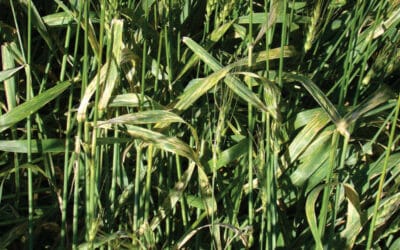Kelly Turkington is an Agriculture and Agri-Food Canada research scientist and plant pathologist based in Lacombe, Alta., who brings more than 35 years of experience with cereal and oilseed diseases and their management to the industry. From the importance of field-based knowledge and correct disease identification to spore trapping and molecular tests to tailor a farmer’s variety selection and in-crop disease management program, Turkington discusses the issues and tools he sees affecting the future of disease management.
ASG: What do you consider one of the most important aspects influencing disease management in the future in Western Canada?
KT: It will be critical to maintain a level of field-based knowledge with respect to disease management, which involves correct disease identification. Although advances in technology will play an important role in the future, it’ll be important for those people entering the industry to still have a good educational background and/or field expertise. Educational resources, field-based research and technology transfer, and on-one-on mentoring will be critical to develop and maintain this capacity.
As we see advances in technology — whether related to molecular biology and phenomics, including alternative strategies for assessing disease, like satellite or drone-based imagery — we need to make sure what we’re identifying based on these new technologies is actually verified in the field in terms of a particular disease issue.
ASG: Is there anything else industry stakeholders, including farmers, can do to improve disease management?
KT: We need to understand the life cycles of the pests we’re trying to manage — how they survive, how and when they develop, and their levels within a field or harvested grain. For example, if a pathogen is only present in small amounts, it will likely have a limited impact on yield, quality and net returns, thus, in-crop fungicide may not be needed. Therefore, understanding the issues you’re trying to manage is key to identifying the most suitable disease control strategies and if they are needed. We can’t underestimate the importance of foundational knowledge regarding the crop we are growing and any potential disease issues.
We get focused on the latest, greatest and newest technologies, but we also need to remember we’re dealing with a biological system. You need to have an understanding of the crop’s biology and the pest species or disease attacking that crop. All farmers may not need that if they are working with an experienced and knowledgeable crop advisor or consultant. The message is, don’t underestimate the need for good field sense, the importance of expertise, and an understanding of the basics.
ASG: Do you see challenges ahead with respect to an understanding of the basics?
KT: It relates to what appears to be a generational shift. At some of the recent farmer meetings I’ve attended, there are more young women and men. Their levels of understanding and field-based expertise may not be the same as some of the older generations of farmers. When it comes to understanding crop production, such as soil fertility, agronomics and pest management, we can’t lose focus of the importance of acquiring knowledge, whether that’s through formal education, technology transfer or mentoring on-farm. We need a certain level of knowledge and awareness, whether the farmer has that, or whether it’s in combination with an experienced crop consultant.
ASG: Are there any other factors that will directly affect disease management in Western Canada, including Alberta?
KT: There are many factors that influence farmers’ cropping choices and rotations, and these factors may overshadow concerns related to disease management. Cropping choices may simply reflect commodity prices, the economics of production, or disease issues — for example farmers may love to grow field peas, but can’t effectively manage Aphanomyces. From a broad perspective, we need a wider suite of cropping options that farmers feel comfortable growing: they know how to manage the crops and the pest issues that affect them.
As important, there must be an established market for the commodities farmers produce and the prices must be reasonable. To me, having a suite of cropping options is a foundational element we need because if farmers have a range of different crop species they know they can get paid reasonably well for, and be successful growing and managing any pest issues that arise, then they can start looking at two or three or more years between host crop species. This non-host rotational interval combined with good volunteer and host weed control allows for decomposition of infested crop residues and the loss of viability of pathogen survival structures.
ASG: How do molecular tools fit into the future picture of disease management?
KT: Western Canada is in a unique position in that we have a series of private sector or commodity group-supported labs, which have built capacity as far as molecular biology is concerned. In many cases these labs started out primarily testing cereal seed for Fusarium graminearum using traditional agar plating, but then transitioned into DNA-based testing technologies.
This molecular expertise continues to expand. Nowadays, labs offer canola residue tests that identify the virulence group of a blackleg pathogen. Therefore, producers can look at the resistance genetics in the varieties they are growing and the nature of the pathogen in their field, and with the assistance of a crop consultant come up with a resistance management plan. That capacity and molecular expertise is at producers’ fingertips. That, to me, is very exciting and continues to grow. Molecular approaches are another tool for assessing the prevalence and nature of a particular pathogen species.
In terms of planning crop rotations, producers can test the virulence spectrum of the blackleg pathogen in a field, for example. Based on the test results, growers can make decisions about the varieties they grow and the rotation they want to follow. Moreover, in the next five to 10 years, there’ll likely be similar approaches to other disease issues in other crop species.
In cereals, we may be able to look at the virulence spectrum of cereal leaf spot pathogens. Growers could take in-season or end-of-growing-season infected plant tissues to the lab. Test results may indicate the farmer has a particular type of pathogen virulence group, which will help dictate the varieties and rotations a grower should use.
ASG: Are there other ways you see molecular techniques influencing disease management?
KT: Fortunately, in Western Canada, our fungicide use patterns have typically been fairly limited up until the last 10 to 15 years. Now, we’re seeing fungicide being put on at flag leaf emergence or before, and once again after head emergence — to top up leaf disease control as well as for Fusarium suppression.
In some cases in Europe and Australia — where there is a much longer history of fungicide resistance development in various pathogens, usually due to repeated use within a growing season or between growing seasons — researchers are investigating the use of molecular techniques to assess infected plant samples or spores captured out of the air by spore traps. The molecular characteristics of the pathogens and their virulence spectrums can be assessed, which can, as mentioned previously, indicate what resistance genes in the host may still be effective in terms of the virulence spectrum of the pathogen. Research efforts are also looking at using molecular markers related to fungi sensitivity.
When I was a student, spore trapping was more of a research-focused activity because it was cumbersome and took a lot of time. Nowadays, with advances in molecular biology, results from spore trap or plant samples are available within one day. Interest in spore trapping technologies is increasing, which may lead to more practical commercial applications. Still, spore traps are focused mainly on research activities, but we’re seeing that change. One option right now is the Spornado technology from 20/20 Seed Labs, which is a passive spore trap.





